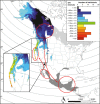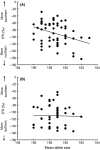Adcyap1 polymorphism covaries with breeding latitude in a Nearctic migratory songbird, the Wilson's warbler (Cardellina pusilla)
- PMID: 27252831
- PMCID: PMC4870208
- DOI: 10.1002/ece3.2053
Adcyap1 polymorphism covaries with breeding latitude in a Nearctic migratory songbird, the Wilson's warbler (Cardellina pusilla)
Abstract
Understanding the genetic background of complex behavioral traits, showing multigenic control and extensive environmental effects, is a challenging task. Among such traits, migration is known to show a large additive genetic component. Yet, the identification of specific genes or gene regions explaining phenotypic variance in migratory behavior has received less attention. Migration ultimately depends on seasonal cycles, and polymorphism at phenological candidate genes may underlie variation in timing of migration or other aspects of migratory behavior. In this study of a Nearctic-Neotropical migratory songbird, the Wilson's warbler (Cardellina pusilla), we investigated the association between polymorphism at two phenological candidate genes, Clock and Adcyap1, and two aspects of the migratory phenotype, timing of spring migration through a stopover site and inferred latitude of the breeding destination. The breeding destination of migrating individuals was identified using feather deuterium ratio (δ (2)H), which reliably reflects breeding latitude throughout the species' western breeding range. Ninety-eight percent of the individuals were homozygous at Clock, and the rare heterozygotes did not deviate from homozygous migration phenology. Adcyap1 was highly polymorphic, and allele size was not significantly associated with migration date. However, Adcyap1 allele size significantly positively predicted the inferred breeding latitude of males but not of females. Moreover, we found a strong positive association between inferred breeding latitude and Adcyap1 allele size in long-distance migrating birds from the northern sector of the breeding range (western Canada), while this was not the case in short-distance migrating birds from the southern sector of the breeding range (coastal California). Our findings support previous evidence for a role of Adcyap1 in shaping the avian migratory phenotype, while highlighting that patterns of phenological candidate gene-phenotype associations may be complex, significantly varying between geographically distinct populations and even between the sexes.
Keywords: Candidate genes; Clock; deuterium; migration distance; phenology; stable isotopes.
Figures




References
-
- Berthold, P. 1996. Control of bird migration. Springer, Berlin: 355.
LinkOut - more resources
Full Text Sources
Other Literature Sources

